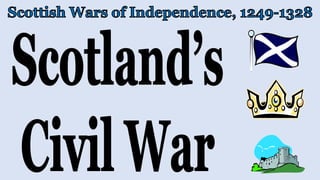
Scottish Wars of Independence - scotland's civil war
- 2. LEARNING INTENTIONS • Describe the key events which shaped the Scottish Civil War, and ultimately ended it • Describe events after the Civil War which let Bruce take control of Scotland, and led up to the Battle of Bannockburn
- 3. It can be argued that Scotland’s Civil War started the moment that Robert the Bruce stabbed John Comyn. From then the nation was divided between supporters of each man.
- 4. Many of Comyn’s supporters and family were also influential, including playing a role in King Edward’s Court. This gave them the chance to seek revenge on Bruce, including using the significant power and resources of England.
- 5. Bruce’s defeats at Methven (June 1306) and Dalrigh (August 1306) were not simply down to the strength of England’s army. In both cases Scots made up a large part of the opposition forces. The attack at Dalrigh was led by John MacDougal of Argyll (Comyn’s cousin)
- 6. The struggles that Bruce faced led to him leaving Scotland (to an unknown location). After being given the nickname King Hob, it is said (wrongly) that Bruce was inspired by a spider to return to Scotland, which he did in February 1307.
- 7. Bruce captured Turnberry Castle (where he had been born) in February 1307 and used the tenants to form an army. However that same month two of his brothers (Thomas and Alexander) were captured by the English and eventually executed.
- 8. Bruce planned a guerrilla campaign against the English. Bruce defeated an English army patrol at Glen Trool in April 1307. The following month, in May 1307, Bruce would again face Valance, his foe from Methven.
- 9. The two sides met at Loudoun Hill in Ayrshire in May 1307 (at a site where William Wallace once fought). Valance had a stronger army but Bruce’s choice of battlefield – limiting the size of area Valance could fight in – gave Bruce victory. More Scots then joined his army.
- 10. Bruce then gained another huge boost to his campaign. King Edward was leading another army north to Scotland, however he died in the north of England in July 1307. His son, Edward II, became the new King of England.
- 11. Bruce now turned his attention to winning full control of Scotland, and this would mean defeating and controlling supporters of John Comyn. In the Winter 1307-1308, Bruce travelled to the north east of Scotland and challenged English forces.
- 12. Bruce captured various Comyn-supporting castles in early 1308: • Inverlochy • Urqhuart • Inverness • Nairn Bruce’s successes persuaded others Scots to join him.
- 13. Bruce then became ill, with many of his men believing that he might die. Bruce’s men had failed to take control of Elgin Castle. They came under attack from the Earl of Buchan, although were not destroyed (partly because of poor coordination between the English army and Comyn’s backers).
- 14. In May 1308, the final battle between Buchan and Bruce’s men took place at Inverurie. Bruce left his sick bed to lead his men to victory. He then took brutal action against the Buchan area. In the Harrying of Buchan, Bruce’s men destroyed homes, food and livestock and killed any Comyn supporters.
- 15. Bruce also had plans to win control of the south of Scotland. During the northern campaign, Bruce sent some men (including his brother, Edward and Sir William Douglas) to the south to fight Comyn’s supporters, and they won control of Douglas Castle in June 1308.
- 16. Bruce then sought to win control of the Western Isles, and take revenge for his defeat at Dalrigh. In August 1308, Bruce’s men challenged and defeated the McDougals at the Pass of Brander in Argyll, winning control of Dunstaffnage Castle.
- 17. Bruce now had control of Scotland. He had defeated many of his enemies, and forced them to join his side. Others gave him their support for fear of being attacked or having their lands taken. In March 1309, Bruce held his first official Parliament (at St Andrews)
- 18. Bruce received official recognition as Scotland’s king from the French king, Philip IV. Bruce was also given the public support of Scotland’s bishops in the Declaration of the Clergy. The Bishops also again reiterated Bruce’s forgiveness for the Comyn killing.
- 19. Although some nobles still resented Bruce, the Scottish Civil War was over by early 1309. Bruce’s next plan was to challenge the English presence in Scotland and win back control of the areas that they controlled.
- 20. King Edward II sent an army north, but they had to retreat to Berwick during the winter of 1309-1310. Bruce led several raids into the north of England and refused to fight the English in a major, open battle. This generally confirmed Edward II’s weakness.
- 21. Over a few years, Bruce and his men (notably William Douglas, Thomas Randolph and Edward Bruce) won control of various Scottish castles: • Dundee, early 1312 • Perth, January 1313 • Dumfries, February 1313 • Edinburgh, early 1314 • Roxburgh, early 1314
- 22. By early 1314, only two major castles remained in English hands; Stirling and Berwick. Stirling was to be handed over to the Scots by Midsummer Day 1314, unless England acted. Edward II was under pressure from his nobles to take action against Bruce and so sent a huge army north.